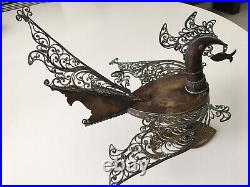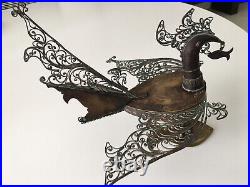












Le Sarimanok est un oiseau légendaire du peuple Maranao originaire de Mindanao, la plus grande des iles méridionales des Philippines. Il en existe en bois, en métal et même en tissu. Sari signifiant tissu et manok oiseau, Sari Manok voudrait dire « oiseau de tissu », mais une autre traduction de sari en ferait un « oiseau imaginaire ». Celui-ci est en laiton. C’est un chef d’ouvre de dinanderie. Il est entièrement démontable. Envergure 27 cm, longueur maximale 24 cm, hauteur maximale 21 cm. Poids environ 380 g. Il a au moins 70 ans car il a été collecté au début des années cinquante par une parente qui travaillait pour l’ONU et qui était alors en poste aux Philippines. Il est en très bon état, très patiné mais sans défauts. Le musée Spurlock, de l’université de l’Illinois en possède un exemplaire très ressemblant, vraisemblablement de la même main, mais plus petit, pesant la moitié de celui-ci, et dont les ailes, la tête et la queue ne sont pas démontables. Voyez la dernière photo. Le Sarimanok est dérivé d’un oiseau totem du peuple Maranao, appelé Itotoro. Selon le peuple Maranao, l’Itotoro est un médium du monde des esprits via son oiseau-esprit jumeau invisible appelé Inikadowa. D’autres sources le rattachent à des traditions islamiques. C’est en tous cas un bel exemple de syncrétisme culturel et un symbole identitaire fort, non seulement pour les Maranao, mais aussi pour l’ensemble des habitants de Mindanao. Envoi en recommandé avec assurance ad valorem. The Sarimanok is a legendary bird of the Maranao people native to Mindanao, the largest of the southern islands of the Philippines. There are wooden ones, metal ones and even fabric ones. Sari meaning fabric and manok bird, Sari Manok would mean « bird of fabric », but another translation of sari would make it an « imaginary bird ». This one is made of brass. It is completely removable. Wingspan 27 cm, maximum length 24 cm, maximum height 21 cm. It is a masterpiece of brassware with a very beautiful patina and flawless. It is at least 70 years old because it was collected in the early fifties by a relative who worked for the UN and who was stationed in the Philippines at the time. The Spurlock Museum at the University of Illinois has a very similar example, probably from the same hand, but smaller, weighing half of this one, and whose wings, head and tail are not removable. Sarimanok is derived from a totem bird of the Maranao people, called Itotoro. According to the Maranao people, the Itotoro is a medium of the spirit world via its invisible twin spirit bird called Inikadowa. Other sources link it to Islamic traditions. It is in any case a fine example of cultural syncretism and a strong symbol of identity, not only for the Maranao, but also for all the inhabitants of Mindanao.

